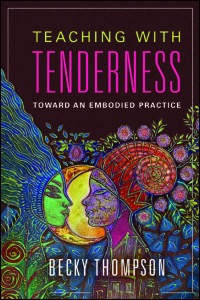
Teaching with Tenderness - Toward an Embodied Practice
Date Reviewed: January 25, 2018
Antagonisms, conflicts, and oppositions characterize societal relations. Becky Thompson acknowledges these realities throughout her book with careful attention and still makes the case for a post-oppositional approach. This is the book’s greatest strength, offering hope and healing through tenderness while walking through the ruin and devastation brought about by dominating power and systems of inequality.
Thompson asks, “What rituals might we incorporate into teaching that invite the body into the classroom? What is it about the structure of academe that leads us to flee our bodies? How can we find them again? What risks will this take? What truths do we need to tell about our lives and our teaching that we have been hiding from ourselves, or barely whispering? How might inviting bodies into the classroom change how we seek justice in the world?” (13). Thompson responds to each of these questions by leading readers through an interdisciplinary and innovative collection of figures and concepts without sacrificing the book’s rigor.
Given the hardening of boundaries and identities in discussions about power and privilege, Thompson’s work brings a refreshing proposal and argument for countering defensiveness and getting to “a soft place with each other” (36). For teachers of all stripes, this means overcoming a dichotomy between mind and body often inherited and passed along in the academe (64). Making a case for “embodied pedagogy” (39), Thompson lifts up the very essential need to facilitate a “resocialization process” (88) whereby students are enabled to feel connected with each other and themselves.
Teaching with Tenderness is exceptional because it does not offer easy solutions. For instance, Thompson notes the difficulty of inviting in people’s personal stories “without encouraging an atmosphere where students feel they must share in order to succeed” (72). For teachers untrained in professional therapeutic strategies, overcoming the desire to “outsource the emotional content of our courses” (89) takes soul work and the willingness to deal with the messiness of what Thompson memorably refers to as “the warp and woof” of that which makes us all human (90).
The book also offers an implicit challenge to teachers, scholars, and researchers for whom gathering data, research, and analysis is part of their bread and butter. While recognizing these as necessary, Thompson notes that academics need to conduct research “with” and not “on” the communities they are describing or analyzing (108).
Thompson’s work speaks to those interested in carving out a new path in teaching and learning where there is neither exclusion nor appropriation, neither denial nor naiveté, neither easy solutions nor pages filled with jargon. This book is a must-read for anyone interested in the challenge and promise of interdisciplinary work that takes the whole person into account as part of envisioning a pedagogy where all things are done as if everyone mattered – body, mind, and all.